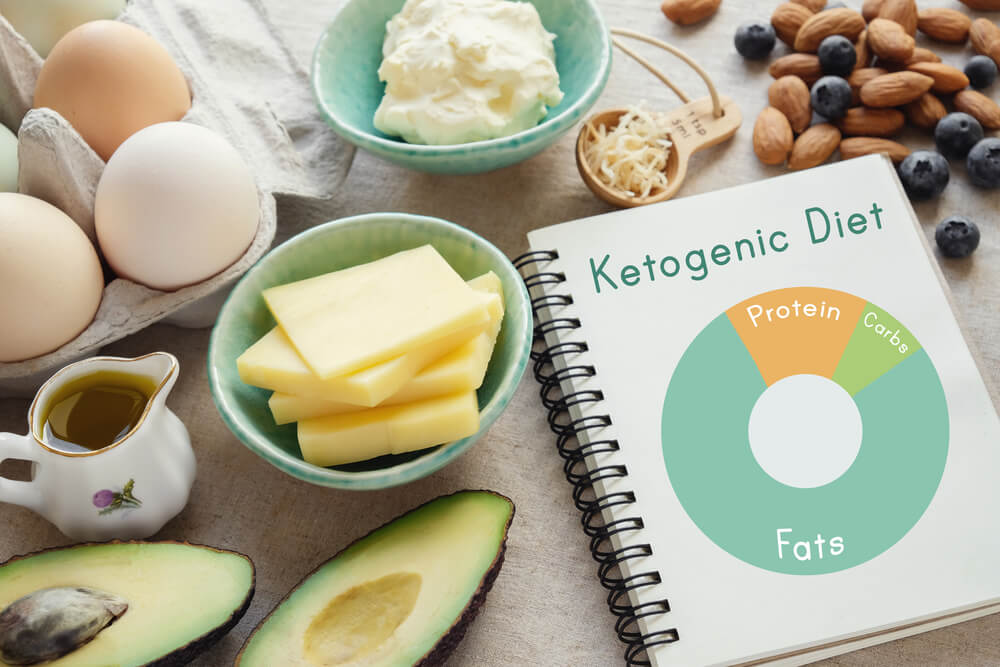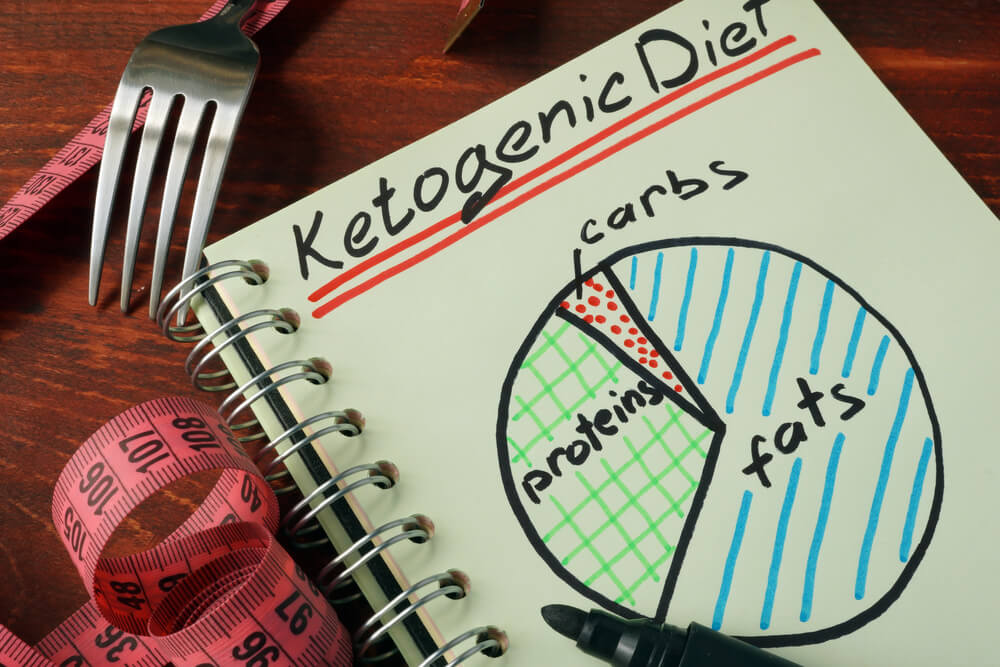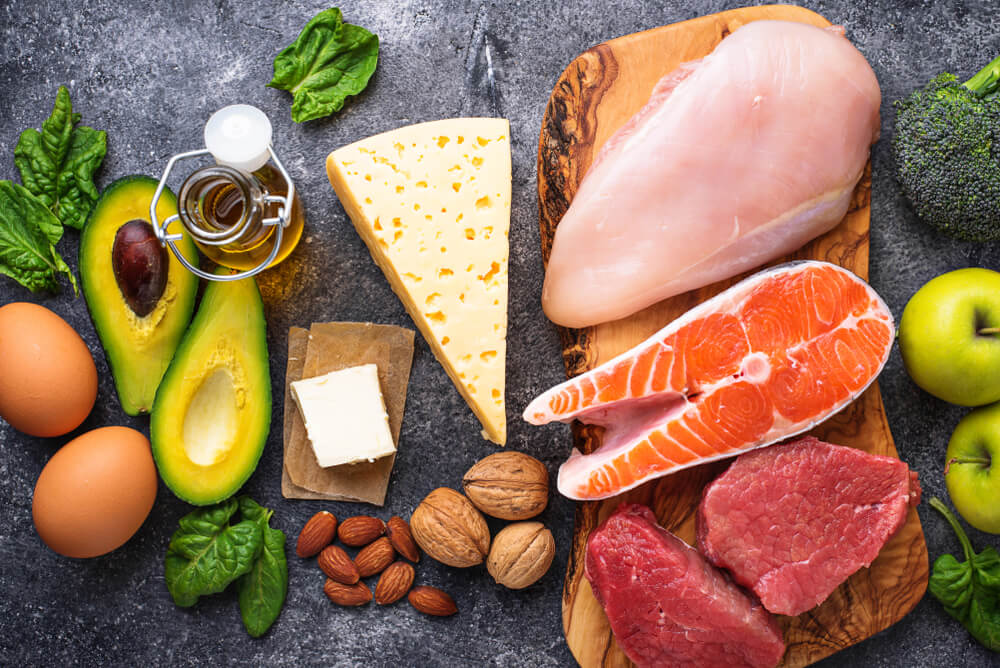
The Keto Diet has been one of the most talked about health-trends this year. Why? Because it goes against everything we have been taught about weight-loss and healthy eating. Most food companies have built their branding on low fat, fat free, whole grain, etc.
This scientifically proven diet focuses on HIGH FAT, low carb nutrients, which induces a state of ketosis where the body produces ketones in the liver to be used as energy.
These ketones burn fat instead of sugar converted from carbohydrates. The end goal of the keto diet is to force your body into this metabolic state.
We don’t do this through starvation of calories but starvation of carbohydrates.
The benefits of the Keto diet go way past losing weight. Studies have shown increased energy levels and therapeutic medical applications. Almost anyone can benefit from eating this type of diet.
On keto, your fat storing hormones, or insulin levels drop immensely which turns your body to burn stored fat. Scientifically, this diet has shown better results compared to any other diet to date.
If you’re pre-diabetic or have type II diabetes, you should consider a ketogenic diet because it naturally lowers blood sugar levels due to the type of food you eat. Studies show it is a more effective way to manage and prevent diabetes compares to low-calorie diets.
Many people also use the Keto Diet specifically for increased mental performance. Ketones fuel the brain with fatty acids, so when you lower carb intake, you avoid sugar spikes in the blood. This means improved concentration and ability to focus.
Fats are naturally more satisfying. They leave us in a “full” state longer. Fats are the most effective molecule to burn as fuel so by giving your body a more reliable source of energy you will feel more energized during the day.
Coffee is allowed but you need to be careful when visiting your local Starbucks and select the keto options that are available

The Keto Diet Guide: Do Eat / Don’t Eat
Okay, so what do you eat on a Ketogenic Diet?
You need to plan ahead and have everything ready and waiting because what you eat depends on how fast you get into a ketogenic state.
The less carbs you eat (less than 15g per day), the faster you enter ketosis.
Keep your carbohydrates coming mostly from vegetables, nuts, and dairy. Don’t eat refined carbs like starch, wheat, or fruit (exceptions are avocado, star fruit, berries).
A quick way to calculate your net carbs is by taking your total dietary carbohydrates, minus the total fiber.
Do Eat:
- Meats- fish, beef, lamb, poultry, eggs, etc
- Leafy Greens – spinach, kale, etc.
- Above ground vegetables – broccoli, cauliflower, etc.
- High Fat Dairy – hard cheeses, high fat cream, butter, etc.
- Nuts and seeds – macadamias, walnuts, sunflower seeds, etc.
- Avocado and berries – raspberries, blackberries, and other low glycemic impact berries
- Sweeteners – stevia, erythritol, and monk fruit.
- Other fats – coconut oil, high-fat salad dressing, saturated fats, etc.
Don’t Eat:
- Grains – wheat, corn, rice, cereal, etc
- Sugar – honey, agave, maple syrup, etc
- Fruit – apples, bananas, oranges, etc
- Tubers – potato, yams, etc.
Anywhere between 25-30g of net carbs is recommended for consistent dieting, but the lowers you keep your glucose levels, the better your results.
During the day, you can snack on nuts, seeds, peanut butter, or cheese to curb your appetite. It is important to remember your nutrient intake should be broken down accordingly.
The best vegetables to eat on a ketogenic diet are dark green and leafy. All meals should definitely be rounded up as protein and veggies, with an extra side of fat.
Here are some examples:
- Spinach, mushroom, and feta omelet with keto coffee
- Whole milk, unsweetened yogurt mixed with full-fat sour cream, raspberries, chia seeds, and walnuts
- Kale salad with bacon, avocado, cheese, pumpkin seeds, and a high-fat salad dressing
- Salmon on top of Kale with lemony basil spread and walnuts
- Chicken breast basted in olive oil, with broccoli and cheese
- Turkey avocado rollups with lettuce and bacon
- Cream cheese cucumber sandwiches
- Steak topped with a knob of butter, and a side of spinach sauteed in olive oil
- Grilled chicken served with eggplant, yellow squash, zucchini sautéed with garlic and olive oil
How To Reach A State of Ketosis
Reaching ketosis can seem complicated and confusing but it is actually pretty straightforward. Make sure you restrict your carbohydrates.
Instead of only focusing on your net carbs, limit your total carbs per day to 35g and net carbs to 20g. It is important to stop worrying about fat.
This is your primary source of energy on veto – so make sure you’re feeding your body enough of it. You will not lose weight on the keto diet by starving yourself.
A lot of people eat to much protein which leads to lower levels of ketosis. For weight loss, you want to eat between 0.5g and 0.8g protein per pound of lean body mass.
Drink a lot of water, no less than a gallon a day. Staying hydrated is super important for the keto diet. It helps control hunger levels, and regulates many vital bodily functions.
It has been researched that snacking spikes insulin and can slow down weight loss.
Weight loss does better with fewer insulin spikes during the day so try to eat fewer meals. In fact, fasting can be a great tool to accelerate ketone levels.

How to know if you’re in Ketosis
There are a couple different ways to test if you’re in ketosis via urine or blood strips. The urine strips are cheap and not super accurate and the blood strips are expensive.
Here is a list of physical symptoms that will let you if you’re on the right track to being in a ketosis state.
- Increased Urination- because keto is a natural diuretic
- Dry Mouth- because increased urination leads to increased thirst and dry mouth
- Bad Breath- from a keynote body called Acetone, that partially excretes from our breath
- Reduced Hunger and Increased Energy- usually happens once you get passed the “keto flu”
Instead of driving yourself crazy measuring and testing, just be sure to focus on the nutritional aspect and stay within your macro ranges.
Conclusion
Your body is used to breaking down carbs and using them for energy, and all of a sudden it has to deal with increased fats and lack of glucose. This can cause a major lack of energy!
In the first week many people report headaches, fogginess, dizziness, etc., identifying what is known as the keto flu.
Once your passed this first week, you will begin to regain your strength and energy back, and notice you feel even better than before.
Ketogenic is both healthier and more effective than low-fat dieting if done correctly.
Beware this is not a pass to eat as many fatty foods as you can. You still need to count calories and stay within your macros. Be careful eating too many nuts, fat bombs, and watch out for hidden carbs!
As a precaution, you should always check with your doctor if you have any concerns if going keto is right for you.
Once you reach your weight goals on keto you can either continue eating keto or try adding a bit more carbs in. If you completely revert to your old habits, you’ll return to the weight and health you had before.
Always make sure to listen to your body and do what you feels best for YOU! I hope this is helpful and good luck in your ketogenic diet journey!
By Megan Heaton
Terry Asher
Latest posts by Terry Asher (see all)
- Better Family – Product Review Liquid Daily 2 oz - Dec 16, 2024
- Post-Workout Recovery: The Key to Optimal Performance - Nov 25, 2024
- Pre-Workout Supplements – Everything You Need To Know - Nov 18, 2024











[…] via- https://gymjunkies.com/keto-diet/ […]
[…] 1, 2018 Facebook Twitter Google+ Pinterest WhatsApp var td_screen_width = window.innerWidth; if ( td_screen_width >= 1140 […]
That’s great, thank you so much for the menu
great, thank you for sharing information. i like your blog
thank you! It is very useful.
[…] is a Keto diet. It includes premium protein and clean fat. Carbs make up just 15 percent of the calories you […]
[…] is a Keto diet. It includes premium protein and clean fat. Carbs make up just 15 percent of the calories you […]
[…] gluconeogenesis, which puts a big strain on it. Additionally, it might be required to perform more ketosis as well, depending on the diet you are […]